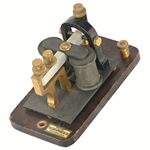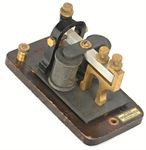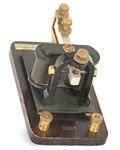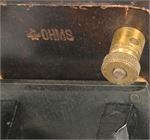Antique Telegraph Sounder by Signal Electric MFG Co - Early 20th Century, 4 Ohms View Watchlist >
- Winning Bid: $60.00
- 24 Bid(s) View Bid History
- High Bidder: tajikbernie@yahoo.com
Seller Accepts Credit Cards
Payment and pickup instructions will be available on your invoice (under "My Account") at the conclusion of this auction.
Lot # A324
System ID # 20762421
Start Date
End Date
1 Watching
Antique Telegraph Sounder by Signal Electric MFG Co - Early 20th Century, 4 Ohms
This antique telegraph sounder was manufactured by the Signal Electric MFG Co., a prominent producer of communication equipment during the early 20th century. The wooden base is marked “4 OHMS,” indicating its electrical resistance, while the brass affixed label denotes it was sold by the Chicago Apparatus Co., a well-known distributor of scientific and technical instruments.
Telegraph sounders like this were pivotal in the era of wired communication, converting electrical signals from a telegraph line into audible clicks, allowing operators to decode messages sent via Morse code. This compact model features a dual-coil mechanism, finely machined brass adjustment screws, and a sturdy steel frame, showcasing the precise craftsmanship of its era. It likely dates to the early 1900s, during the height of telegraphy as the primary method of long-distance communication before the telephone became widespread.
This historical piece remains a fascinating artifact of technological innovation and would make an excellent addition to any collection of vintage scientific instruments or telegraphy memorabilia.
Condition:
Good condition with age-appropriate wear. The wood base shows light surface marks, and the brass and steel components exhibit a rich patina consistent with its vintage nature. Sold as shown.
Dimensions:
3 1/2" x 3" x 5 1/2" (8.9 x 7.6 x 14 cm).
Historical Context:
The Signal Electric MFG Co. was a key player in the production of telegraphy and signaling devices in the late 19th and early 20th centuries. Devices like this telegraph sounder were essential tools for communication across railways, military operations, and commercial enterprises, representing a technological milestone in human connectivity. The Chicago Apparatus Co., known for supplying educational and technical instruments, added credibility to this piece by distributing it to schools, businesses, and technicians, further cementing its utility and historical significance.




